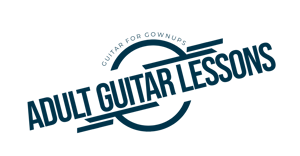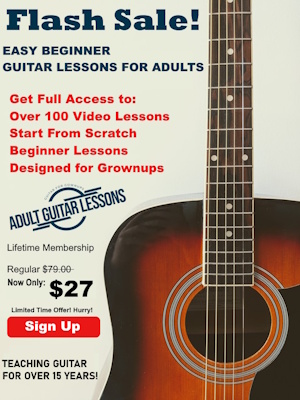Turn on the TV on any given night and pay attention to the commercials.
One thing you will notice is the disproportionate number of ads that target a younger audience. The fact is that many advertising budgets are focused on separating the 35 year old and under demographic from their wallets.
As we get older – past 50, 60 or 70 – it is sometimes hard to admit that we are no longer part of the “cool” generation that these advertisers are forking out big bucks to appeal to.
Sure, there are the “senior” organizations and pharmaceutical ads beamed in our direction – but how cool is that?
If you’ve shopped around for guitar lessons you may have experienced a similar revelation.
Studies show that the prime demographic for guitar lessons is the “12 to 25 year old males” category.
As a result, most guitar lessons courses target this segment of the beginner guitar population. And understandably so – that’s where the money is.
If you’re considering picking up the guitar “later in life”, then it’s important to realize there are dramatic differences between guitar lessons designed for a younger crowd, and adult guitar lessons.
When shopping particular guitar courses, be aware of certain key words that will indicate to you that the program is focused on selling to the younger demographic. Words and terms like:
– Shredding
– Speed Picking
– Become a Guitar God
– Blazing Fast
– Be a Guitar Superstar
Also note the artists and songs that the course teaches. If you see names of songs and artists that you don’t recognize, then that may be an indicator that the course is primarily intended for the 12 to 25 age group.
That’s not to say that any of these courses are bad, in fact there are a number of good ones out there – it’s just to say that, as an older, more mature guitar student, one of these courses may not be the best choice for you.
So how do you choose?
First understand that you will need to decide what “type” of guitar lessons program is best for you. Basically you have a few choices – private guitar lessons, home study guitar lessons, online guitar lessons, and going it alone.
1. Private Guitar Lessons
This is a great way to go, if you can afford it. Like any program, not all instructors are created equal. You will be making a considerable investment in private lessons so don’t hesitate to “interview” a number of instructors before making a decision.
2. Home Study Courses
These usually include DVDs, CDs and books, and there are a number of good courses on the market. Be sure to determine to “target audience” of these courses before buying because, although less expensive than private lessons, some can be a little on the pricey side.
3. Online Guitar Lessons
This is typically the most economical solution, but care should be taken when shopping. Like any other course, determine what generation the material taught is focused on.
4. Going it Alone
There is so much free information floating around on the internet that it’s often tempting to attempt learning guitar by grabbing bits and pieces of “this and that”. These students are often referred to as “Google Guitarists”. The problem is, without a structured learning program to follow, most of these students flounder and eventually end up quitting the guitar in frustration.
Once a decision is made as to what type of guitar lessons program is right for you, then take a hard look at the guitar instructor. Guitar lessons instructors can range from well known international guitarists, to veritable “youngsters” barely out of school.
Quite often, guitar students of “our generation” relate better to an instructor with a wealth of “real world” guitar playing experience, coupled with a healthy dose of “life experience”.
Learning how to play the guitar is a fulfilling and rewarding experience at any stage in life, and choosing the right adult guitar lessons program will ensure that the joys of making music stay with you for many years to come.



